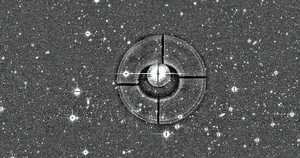AUTOMASK¶
Software Description¶
Optical Astronomical Images often suffer from bright stars and other large- and small scale features that we would like to exclude from the object detection process. At least, we want to know the location and shape of those areas so that object catalogues can be cleaned afterwards. Of course, the areas which need to be cleaned heavily depend on the science project for which data were obtained. The software of this module was intentionally written and optimised for deep, extra-galactic Wide-Field Imaging observations of empty fields. Our main scientific drivers:
- weak gravitational lensing studies of faint and small background galaxies
- the estimation of photometric redshifts from multi-colour observations of faint galaxies
require the accurate determination of galaxy surface brightness moments to at least fourth order. Hence, we want to exclude all image areas in which the light distribution of faint objects (often confined to a very small number of image pixels) is probably altered by other sources. Amongst such defects are:
- Extended haloes of very bright stars
- Defraction spikes of stars
- Areas around bright and extended galaxies
- Various kinds of reflections.
This package implements several algorithms for an automaatic detection and masking of these features. The interface consists of stand-alone C-routines and bash shell scripts.
The ideas and algorithms were described in more detail in the articles A&A 470, 821 (Dietrich et al.) and A&A 493, 1197 (Erben et al.).
Examples¶


The images show a region from a MEGAPRIME@CFHT imahe without and with ds9 region files. The masks were created with the automask package.
Software Prerequisites¶
- You need the THELI pipeline software installed
- The software makes several implicit assumptions on your data.
The following preconditions should be fulfiled if you processed
your data with THELI:
- The masking procedures operate on deep, co-added images
- Your science image must contain valid astrometric information in the image headers.
- Your science image must be accompanied by a weight map of SExtractor type MAP_WEIGHT
- Your science image should be accompanied by a flag map. This flag should contain a non-zero value where the weight is zero and a zero everywhere else.
Software Download¶
Please find the latest version of the software here
The software comes with HOWTOS that show its application on example data sets from WFI@MPG/ESO2.2m and MEGAPRIME@CFHT.
Software Authors and Software License¶
The software is maintained by Thomas Erben at the Argelander-Institut für Astronomy in Bonn/Germany. Please email_me with your questions, suggestions and comments. Automask is released under the GNU General Public License, version 2.
Core parts of the software were contributed by Jörg Dietrich, Hendrik Hildebrandt, Tim Schrabback and Ludovic van Waerbeke.
Acknowledgements¶
If you use automask for your own research, please cite it with the articles A&A 470, 821 (Dietrich et al.) and A&A 493, 1197 (Erben et al.).